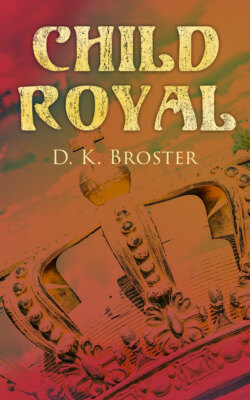Читать книгу Child Royal - D. K. Broster - Страница 4
На сайте Литреса книга снята с продажи.
THE PICTURE
ОглавлениеTable of Contents
Before the flames so lamentably had their will of Garthrose House in 1896, there used to hang in the hall a small painting which caught the eye at once by its unlikeness to any of the more important-looking and better executed portraits of a later date, the Allan Ramsays, or the Raeburn, or even to the dark-backgrounded family pictures belonging to periods nearer to its own. Childish visitors in particular were sure to be attracted to this painting, and their questions were generally identical in substance: “Why is there another little picture painted inside this picture, please?” “Who is the little girl in it?” “Are the lady and gentleman her father and mother?” Or sometimes it would be, not a query, but a request: “Grandfather, will you show us the funny picture?”
And to the questions Sir Patrick Graham would answer: “No, my dear, the lady and gentleman are not the parents of the little girl; they are my ancestors—and yours as well,” he would add, if the case required it. Then, if the small visitor were below a certain stature, he or she might be lifted up. “Suppose we look closer. You see that crown on the frame of the picture of the little girl? Now can’t you guess who she is? . . . Mary Queen of Scots when she was quite small, between eight and nine years of age, though she looks a good deal older, doesn’t she, in that stiff bodice and that tight-fitting head-dress? The whole picture was painted when she was a child in France, before she was married to the little boy—the Dauphin—with whom she was brought up, and who became, you know, King Francis II of France.”
“Is that why there is a crown on the frame?”
“No, the crown is there because Mary was a Queen already. She had been Queen of Scots since she was a week old.”
“Did she have to do lessons, like us, when she was little?”
“Indeed she did, and when you go to Paris you will see her Latin exercise-book in the great library there.”
“But did she have toys, too?”
“Yes, and a great many pets, and dresses and jewels, because she was a very important little person, although she was only a child like you.”
“And why are those two people with stiff white things round their necks holding her picture like that?”
“Because they both had to do with her in those days, and they were very fond of her.”
And the child would gaze at that other child whose name at least was familiar, and perhaps her fate, too. The lady and gentleman in the painting, who were Sir Patrick’s ancestors, sat either side of a small table covered with a dark velvet cloth reaching to the floor. They were looking neither at the spectator nor at each other, but towards the oval picture of the little Queen, along the top of which the farthest hand of each was laid, thus holding it upright on the table.
It would probably be an older visitor to Garthrose who would observe further details in this somewhat unusual picture. On the front of the table-cloth was emblazoned a shield with the family quarterings, the scallop-shells and roses, surmounted by the mailed hand holding a rose branch which was the special cognisance of Graham of Garthrose, under the scroll bearing the motto which went with it, Par heur et malheur. There was nothing out of the common about this heraldic display, but what was apt to excite a connoisseur’s curiosity was the presence on the floor in the foreground of a sort of plaque, showing the same shield traversed by the bend sinister of illegitimacy. Near it lay an open letter across which a little snake was crawling.
And to one such visitor old Sir Patrick said with a sigh: “Yes, some fated natures throw an early shadow. Even as a child Queen Mary was, through no fault of her own, the cause of anguish to those who loved her. We had cause enough in my family to know it. . . . You are familiar with her own chosen motto: In my end is my beginning? I sometimes think it should have been reversed.”
“That same thought has come to me before now,” answered his hearer. “There is, of course, a story—a dark story, perhaps—in that enigmatical picture?”
Sir Patrick Graham bent his handsome grey head in assent. “You shall hear it to-night, if you care to.”
